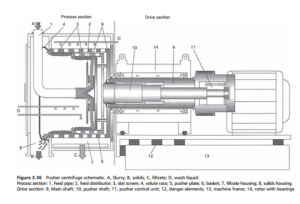0
-
An empty cart
You have no item in your shopping cart
envato-wordpress-toolkit domain was triggered too early. This is usually an indicator for some code in the plugin or theme running too early. Translations should be loaded at the init action or later. Please see Debugging in WordPress for more information. (This message was added in version 6.7.0.) in /var/www/wp-includes/functions.php on line 6121g5plus-darna domain was triggered too early. This is usually an indicator for some code in the plugin or theme running too early. Translations should be loaded at the init action or later. Please see Debugging in WordPress for more information. (This message was added in version 6.7.0.) in /var/www/wp-includes/functions.php on line 6121The moving bed centrifuge with a cylindrical basket is known as the pusher centrifuge, and is one of the most common types of centrifuge for separating fast-draining crystalline or fibrous solids from suspension, at high throughput rates of solids. In
its basic action, a layer of filter cake forms on the inside of the basket, near to the machine ’ s feed end. This is then pushed along the basket (hence the machine’ s name) by a reciprocating plate, after which the plate withdraws to its rest position, allowing another ring of cake to form. On its next forward stroke, the pusher plate forces both rings towards the exit of the basket, then retracts, so that a third ring forms and so on.
In a typical machine, the feed suspension flows continuously from the stationary feed pipe, mounted at the axis of the centrifuge. It flows onto a rotating cone designed to accelerate the feed up to the rotational speed of the basket. From this accelerating cone, the feed flows over the face of the pusher plate on to the rear of the basket, as shown in Figure 3.36 (which actually illustrates a two-stage pusher). The bulk of the mother liquor drains quickly through the basket, and a cake forms and spreads out over the screen. The forward stroke of the pusher plate advances this layer of cake towards the open front end of the centrifuge as more solids are added to the cake. Then the return stoke of the pusher plate creates space on the screen, which is filled by more of the feed solids, so that the next forward stroke of the pusher plate acts on this new layer and pushes it and the previously laid material both forwards on the screen.
As the successive layers of cake are moved along the basket, excess mother liquor left adhering to the cake is removed by washing, using spray nozzles below the feed pipe. The reciprocation of the pusher plate is usually generated hydraulically,
by means of oil pressure exerted on alternate sides of a piston situated on the push shaft. The necessary oil pressure is provided by a dual screw pump, the alternating pressure, on either side of the piston, being controlled by proximity switches.
The pusher may have one basket or more than one, in a multi-stage form as shown in Figure 3.37. In a one-stage machine, the reciprocating part is the pusher plate itself, carrying the acceleration cone. There is just one basket, and the plate
moves back and forth over this basket and as close to it as possible, without wearing the screen surface. In a two-stage machine (shown also in Figure 3.37 ) the pusher plate does not move along the machine axis, and it is an inner basket that
reciprocates. The front of this screen does the pushing of cake along the surface of the outer basket, and its return stroke leaves space free on the outer screen, which is filled by the solids falling over the front of the smaller screen as they are scraped along by the central, non-reciprocating carrier plate of the acceleration cone. The tumbling action over the front of the smaller screen helps to break up, and hence dewater, any agglomerates that may have formed on the screen surface.
The smallest and largest of the three screens in a three-stage pusher do not reciprocate, the pushing action being undertaken by the middle screen and the central plate carrying the acceleration cone. Four-stage pushers exist (for solids needing very efficient washing), and now stages 1 (the smallest diameter) and 3 reciprocate, while


A more complex design of pusher, although saving of space where more then one machine is required, has the drive and push mechanisms mounted centrally on a common axis, with a basket at each end of the drive shaft. In this way, the forward stroke in one basket is the backwards stroke in the other.